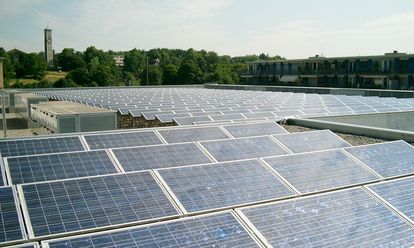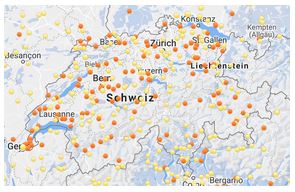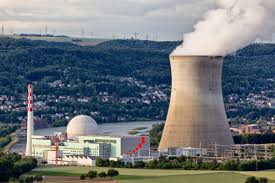Nuclear energy is primarily called the technology for secondary energy by nuclear fission. This technology has been used on a large scale to produce electricity since the 1950s.
As of January 2020, 447 reactor units with a total capacity of 397 GW were in operation in 31 countries. A further 53 reactor units with a total capacity of 54.7 GW are under construction. In addition, more than 100 nuclear power plants are planned for the coming decade.
Nuclear energy is obtained from nuclear, known as "radioactive" fuel. In this process, natural uranium is enriched and then used in a nuclear fission reaction to generate heat. Nuclear energy has the great advantage of being relatively cheap and environmentally friendly. At present, uranium is also still available in relatively large quantities.
However, the cost of mining uranium is very high. In addition, large amounts of CO2 are produced in the process, which has a very unfavorable effect on the climate. However, opponents see the greatest danger in the event of a nuclear meltdown.
Source:
https://de.wikipedia.org/wiki/Kernkraftwerk
https://www.verivox.de/strom/themen/atomkraftwerk/
Which raw material is needed?
A) carbon
B) uranium
C) palladium
D) copper
In this post it will explain how a wind turbine works and the context of its use in Switzerland.
What is Wind and how we can use this to generate electricity?
Wind is the result of the sun's uneven heating of the atmosphere. Warm air expands and rises, and cool air contracts and sinks. This movement of the air is called wind. [1]
How does a wind turbine work?
The wind turbine consists of a mast, a rotor and a generator . The mast is up to 164m high, but can reach over 200m. The rotor has a diameter of up to 10 metres. This has an output of up to 2-3 MW. Behind the rotor is a generator which generates electricity through the rotation of the rotor. [2]

The picture shows a classic wind turbine on a wind farm on the water. [3]
Wind turbines use the kinetic energy of the incoming air to rotate the blades. The More...
Natural gas is a fossil fuel(1) that essentially(2) consists of methane(3). Methane is a hydrocarbon(4) with a high energy content that causes the lowest carbon dioxide emission of all fossil fuels. This hydrocarbon is split into hydrogen and carbon monoxide in the fuel cell system and converted into electricity. There is already an extensive(5) infrastructure for the production and use of natural gas. The natural gas resources are large, but ultimately finite(6). [1]
Gas is a non-renewable energy. Non-renewable energy is the largest part of Swiss energy consumption, namely around 79 percent. Because there isn't any fossil fuels found in Switzerland. That means they have to be imported from abroad. [2]

Quiz:
Do we have unlimited source of gas?
* yes
* no
Vocab:
(1) fossile Brennstoffe
(2) hauptsächlich
(3) Methan
(4) Kohlenwasserstoff
(5) umfangreich
(6) endlich
Sources:
[1] http://www.hexis.com/de/energietr%C3%A4ger-erdgas
[2] https://konsum.ch/erdgas-preise/
Photovoltaics
Photovoltaics (PV) is the conversion of light into electricity using semiconducting(1) materials that exhibit(2) the photovoltaic effect. The photovoltaic effect is the generation of voltage and electric current in a material upon exposure to light.
A photovoltaic system employs solar modules, each comprising a number of solar cells, which generate electrical power.
PV installations may be ground-mounted, rooftop mounted(3), wall mounted or floating. The mount may be fixed or use a solar tracker to follow the sun across the sky.

Did you know? The term "photovoltaic" comes from the Greek (phōs) meaning "light", and from "volt", the unit of electromotive force, the volt, which in turn comes from the last name of the Italian physicist Alessandro Volta, inventor of the battery.
More...
The wind is a clean, free, and readily available renewable energy source. Each day, around the world, wind turbines are capturing the wind’s power and converting it to electricity. Wind power generation plays an increasingly important role in the way we power our world – in a clean, sustainable manner. More...
Solar energy is full of advantages:
You become more independent from the power grid, you save money and electricity - and you increase the value of your property.

How does solar panels work?
Step 1: Sunlight activates the panels.
Step 2: The cells produce electrical current.
Step 3: The electrical energy is converted.
Step 4: The converted electricity powers your home.
Step 5: A net meter measures usage.
At the end of 2019, there were about 100,000 photovoltaic systems in Switzerland. These ones produce around 4% of the total electricity consumption.
On this map below you can see where solar radiation is the highest in Switzerland. On the map on the right side you can see, where the photovoltaics pannels are installed.

In which two cantonc are the highest solar radiation?
Sources:
Swisssolar
Solar 101 - The 5 steps of photovoltaics
Nuclear energy is one of Switzerland's most important sources of energy. 35 % of total electricity generation is derived from nuclear energy. Currently, three locations operate four reactor units. Switzerland is one of 13 countries that generate a quarter of its energy from nuclear power. In an international comparison, our nuclear power units perform very well, as we carried out strict checks after the disaster in Fukushima.

The reactor units have a total capacity of 3,095 megawatts. That is 3'095'000'000 watts, for comparison: 1 gram of water can be heated by 14.3 degrees Celsius with 1 watt.
Nuclear energy is very controversial in Switzerland; 9 referendums have already attempted to force the phasing out of nuclear energy. The construction of new nuclear power plants was banned in 2017. Nevertheless, a clear majority of 64% supports nuclear energy as long as it can be generated safely. In the future, this will initiate the gradual phase-out. That makes Switzerland, together with Germany, the only Nations who are actively phasing out nuclear energy.
Quiz question:
Which of these countries has the most reactor units?
☐ China
☐ Russia
☐ France
The solution is France with 58 reactors.
Vocabular:
referendums -> Volksinitiative
Sources:
Kernenergie in der Schweiz (Wikipedia.org)
Kernenergie weltweit (Kernenergie.ch)
Abstimmungen KKW (uvek.admin.ch)
Vocabular:
referendums -> Volksinitiative
Dario & Justin
Thermal energy is technically heat. With thermal heat we can boil liquids and with the steam you can drive a turbine. The average daily radiation power reaching the earth's surface (based on 24 hours) is approximately 165 W/m² worldwide. The use of solar thermal energy was already practised in ancient Egypt, Mesopotamia and in the early South American advanced civilisations through the architecture of their buildings.
It's an ineffective type of energy production, since it only works with steam and not directly with water. Also, a lot of vapor is produced, which isn't able to turn a turbine.
Examples are solar plants or water heating roofs.

What is water?
a: a liquid
b: a solid
c: a gas
Where does nearly all off the energy in the atmosphere come from?
Wikipedia
Ulza, Lukas, Livia
Geothermal the new energy from the ground
Did you know we can use energy from the ground to heat our houses and buildings?
The earth holds a lot of heat in its interior. With a combination of geothermal and heat pumps, it is now possible and it also saves energy. Because of the high potential, there are even new trials to produce electricity with earth's heat, but that needs a bit more time to be perfect.
This new way of heating saves our environment and has many more good aspects. :)
More...
Our house is heated with natural gas (our hot water is also heated with natural gas).
.jpg)
The appropriate gas is burned in the gas burner, and it can be fed into the burner at any time due to a slight overpressure of the gas pipe. The resulting heat is transferred via a heat exchanger to the ready heating water of the natural gas heating system and then pumped along with the water via a circulation pump to the radiators. The radiators then release the heat generated into the environment. Meanwhile, the cooled water flows back to be heated again. (https://www.thermondo.de/info/rat/gas/warum-ist-eine-erdgasheizung-so-gefragt/)
